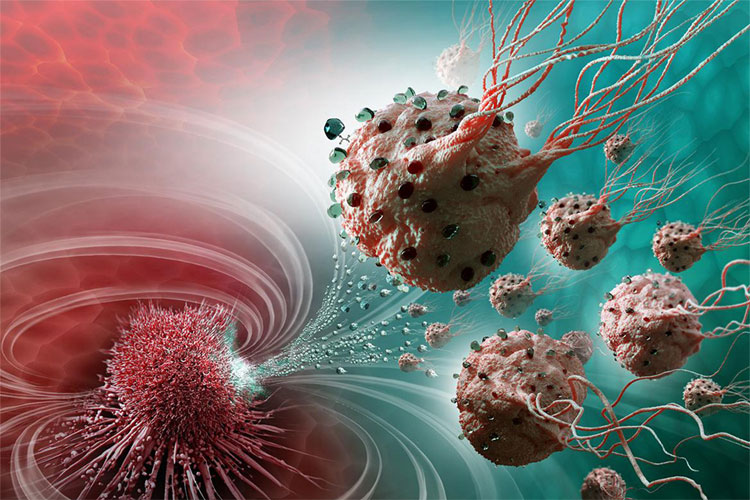Micro-robot warrior looking for cancer cells
A Canadian team developed a micro-biological robot capable of transporting specific drugs to the right cancer cells that are active.
According to Phys.org, in the study published in the journal Nature Nanotechnology on August 15, scientists from Montréal Polytechnic University and McGill University, Canada found a way to use biological robots as small as the size. molecules, carrying on their own special drugs, crept into blood vessels to kill cancer cells.
The method of using robotic drugs ensures maximum effectiveness for targeted tumors, limiting the danger to the surrounding healthy organs and tissues. This is considered a spectacular breakthrough in cancer treatment research.

Biological robot armies include more than 100 million whip bacteria capable of carrying drugs to attack cancer cells.(Photo: Montréal Polytechnic University).
"The nano robot war corps is actually more than 100 million whip bacteria capable of moving and filling themselves. They move along the shortest path between the injection site and the cancer cell area." Professor Sylvain Martel, chairman of the Medical Nano Robot Research Council and director of Nanorobotics Laboratory, Montréal Polytechnic University, explained. "These biological robots can carry drugs deep into the tumor."
In addition, biological robots can automatically detect areas of cancer cells growing through special mechanisms called " hypoxic zone". The "Hypoxic zone" is an area that lacks oxygen, because cancer cells often develop excessive oxygen. The robots automatically detect oxygen depleted places and bring the medicine to the right address. Currently, the "hypoxic zone" is inaccessible and treated with conventional methods, including radiotherapy.
For mobility, the Martel group's biological robot is based on two natural mechanisms. A type of compass is created by synthesizing magnetic nanoparticles, allowing them to move in the direction of the magnetic field controlled by a computer. Meanwhile, a sensor that measures oxygen levels allows them to hunt for "hypoxic zone". By exploiting these two mechanisms, scientists have shown that whip bacteria can function as artificial biological robots in many fields.
"Chemotherapy, which is toxic to the entire body, can be replaced by biological robots that bring drugs to the correct tumor position, eliminating harmful side effects and enhancing treatment effectiveness , " said Professor Martel. said.
- Put the micro algae robots into the body to spy on and treat cancer
- The 'army' of microscopic robots looks for cancer cells
- Introduce robot can learn as human brain
- DNA robots can kill cancer cells
- The most powerful warriors in history
- Image of cancer cells under a microscope
- The chip helps detect early cancer cells
- 'Chiêu' new treatment for liver cancer
- 'Ultra-small submarine' carries drugs that kill cancer cells
- The smallest reconnaissance robot in the world
- Use a robot to remove objects in the stomach
- Technology causes cancer cells to destroy themselves
 Why is Australia the country with the highest cancer rate in the world while Vietnam ranks 100th?
Why is Australia the country with the highest cancer rate in the world while Vietnam ranks 100th? New drug causes cancer to 'starve'
New drug causes cancer to 'starve' Common cancers in men
Common cancers in men America's incredible discovery: The most feared cancer cell is love
America's incredible discovery: The most feared cancer cell is love